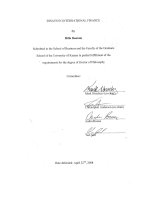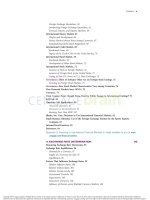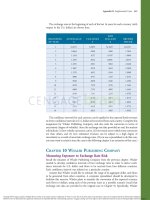essays in international financial management
Bạn đang xem bản rút gọn của tài liệu. Xem và tải ngay bản đầy đủ của tài liệu tại đây (1.49 MB, 243 trang )
ESSAYS IN I NTERNATIONAL FINANCIAL MANAGEMENT
DISSERTATION
Presented in Partial Fulfillment of the Requirements for the Degree Doctor of Philosophy
in the Graduate School of The Ohio State University
By
Chuan (Rose) Liao, B.S.
Graduate Program in Business Administration
The Ohio State University
2010
Dissertation Committee:
Professor G. Andrew Karolyi, Co-Advisor
Professor Michael S. Weisbach, Co-Advisor
Professor Ruediger Fahlenbrach
Professor Isil Erel
Copyright by
Chuan (Rose) Liao
2010
ii
ABSTRACT
The first essay in the dissertation examines the motives for and the consequences of
corporate block acquisitions around the world. I propose and test a number of competing
explanations for why corporations purchase (sell) equity stakes from (to) other firms.
Using a broad sample of 24,143 minority block acquisitions by corporations from 43
countries, I find that the relief of financial constraints is the primary motive for the sale of
equity stakes. Corporate block acquirers often have expertise in the targets’ industry,
thereby helping to certify the investment opportunities of target firms and so allowing
them to raise additional capital. There is little evidence in support of competing theories
that corporate block acquirers lower contracting costs in the product market, that they
effectively monitor insiders or that they capitalize on their overvalued stocks.
The second dissertation essay examines the motives for and consequences of 5,317
failed and completed cross-border acquisitions constituting $619 billion of total activity
that were led by government-controlled acquirers over the period from 1990 to 2008. We
find that government-led deal activity is relatively more intense for geographically-closer
countries than that of corporate acquirers, but also relatively less sensitive to differences
in the level of economic development of the acquirer’s and target’s home countries, in the
quality of their legal institutions and accounting standards, and to how stringent are
restrictions on FDI flows in their countries. Government-led acquirers are more likely to
iii
pursue larger targets with greater growth opportunities and more financial constraints
than corporate acquirers. But, the share-price reactions to the announcements of such
acquisitions are not different from those led by corporations. Among those deals
involving government-controlled acquirers, we do find important differences involving
sovereign wealth funds (SWFs). SWF-led acquisitions are less likely to fail, they are
more likely to pursue acquirers that are larger in total assets and with fewer financial
constraints, and the market reactions to SWF-led acquisitions, while positive, are
statistically and economically much smaller.
The third essay studies the motives for cross-border mergers by corporations.
Despite the fact that one-third of worldwide mergers involve firms from different
countries, the vast majority of the academic literature on mergers studies domestic
mergers. What little has been written about cross-border mergers has focused on public
firms, usually from the United States. We provide an analysis of a sample of 73,015
cross-border mergers occurring between 1990 and 2007. We first characterize the
patterns of who buys whom: Geography matters, with firms being much more likely to
purchase firms in nearby countries than in countries far away. Purchasers are usually but
not always from developed countries and they tend to purchase firms in countries with
lower investor protection and accounting standards. A significant factor in determining
acquisition patterns is currency movements; firms tend to purchase firms from countries
iv
relative to which the acquirer’s currency has appreciated. In addition a country’s stock
market returns lead to acquisitions as well. Both the currency and stock market effect
could reflect either misvaluation or wealth explanations. Our evidence is more consistent
with the wealth explanation than the misvaluation explanation.
v
DEDICATION
To my Father and Mother, Minggang Liao and Li Li: thank you for the constant
encouragement and support.
vi
ACKNOWLEDGMENTS
I thank Andrew Karolyi for his insight and direction, and for the countless hours spent
listening, teaching, and encouraging. I hope that I will be able to inspire students in the
same way he has inspired me. I thank Mike Weisbach for his helpful comments, patience,
and for the time and effort that he put into my education. His advice has been invaluable.
I also thank the members of my committee, Ruediger Fahlenbrach and Isil Erel for their
guidance, input, encouragement, and mentoring. I am grateful to Bernadette Minton,
René Stulz, and the faculty in the Department of Finance for their comments and advice.
Finally I am grateful to my colleagues, particularly my officemates Taylor Nadauld and
Jérôme Taillard for their friendship, support, and help along the way.
vii
VITA
2002………….B.S. Economics, Shandong Institute of Economics, P.R.China
2002-2004… Graduate Associate, Accounting and Finance, University of Manitoba,
Canada
2004-2009 Graduate Associate, Department of Finance, The Ohio State University
2009-present Instructor, Finance and Economics, Rutgers University
PUBLICATIONS
“Testing for the Elasticity of Corporate Yield Spread” (with Gady Jacoby and
Jonathan Batten), Journal of Financial and Quantitative Analysis, 2009, v44(3), 641-656.
“A (Partial) Resolution of the Chinese Discount Puzzle: The 2001 Deregulation of
the B-share Market” (With G. Andrew Karolyi and Lianfa Li), Journal of Financial
Economic Policy, 2009, V1(1), 80-106.
FIELDS OF STUDY
Major Field: Business Administration
Concentration: Finance
viii
TABLE OF CONTENTS
ABSTRACT .ii
ACKNOWLEDGMENTS vi
VITA vii
LIST OF TABLES xiii
LIST OF FIGURES xvi
CHAPTER 1: INTRODUCTION 1
CHAPTER 2: CORPORATE BLOCK ACQUISITIONS AROUND THE WORLD 11
2.1. Introduction 11
2.2. Potential Explanations for Corporate Block Acquisitions 17
2.2.1. Product Market Relationships and the Contracting Motive 17
2.2.2. Financial Constraints and the Financing Motive 19
2.2.3. Investor Protection and the Governance Motive 21
2.2.4. Market Conditions and the Timing Motive 23
2.3. Data and Sample Statistics 24
ix
2.4. Which Firms Have Corporate Blockholder 33
2.5. The Announcement Effects of Corporate Block Acquisitions 35
2.4.1. Univariate Analysis 36
2.4.2. Multivariate Analysis 38
2.4.3. Acquirer Information Advantage 40
2.4.4. Robustness Checks 42
2.6. New Issues 45
2.7. The Long-Run Impact of Corporate Blockholders on Target Firms 50
2.7.1. Univariate Analysis 50
2.7.2. Multivariate Analysis 52
2.8. Conclusion 54
CHAPTER 3: WHAT IS DIFFERENT ABOUT GOVERNMENT-CONTROLLED
ACQUIRERS IN CROSS-BORDER ACQUISITIONS? 56
3.1. Introduction 56
3.2. Data and Descriptive Statistics 70
x
3.2.1. The Same of Cross-Border Deals 70
3.2.2. Summary Statistics 73
3.3. Determinants of Cross-Border Acquisition Activity Led by Government-
Controlled Acquirers 75
3.3.1. Measuring the Level of Cross-Border Acquisition Activity by Type of Acquirer 75
3.3.2. Evaluating Alternative Hypotheses for Cross-Border Acquisition Activity 78
3.3.3. Country-Level Results 84
3.4. What Factors Drive Government-Controlled Acquirers in Cross-Border Deals 90
3.4.1. Logistic Regression Analysis 90
3.4.2. Evaluating Alternative Hypotheses for Deal Determinants 93
3.4.3. Deal-Level Results 95
3.5. Market Reactions to Announcements of Cross-Border Deals Led by Government-
Controlled Acquirers 100
3.5.1. Cumulative Market-Adjusted Returns (CMARs) 102
3.5.2. Cross-Sectional Test Results 105
xi
3.6. Concluding Remarks 109
CHAPTER 4: WORLD MARKETS FOR MERGERS AND ACQUISITIONS 114
4.1. Introduction 114
4.2. Prior Literature on Cross-Border Mergers and Acquisitions 120
4.3. Data 123
4.4. Results 125
4.4.1. Stylized Facts about Cross-Border Mergers 125
4.4.2. Cross-Sectional Determinants of Cross-Border Mergers 127
4.4.3. Differences in Valuation Using Country-Level Panel Data: Univariate Evidence129
4.4.4. Differences in Valuation Using Country-Level Panel Data: Multivariate Evidence132
4.4.4.1 Interpreting the Relation between Valuation and Merger Propensities 136
4.4.5. Valuation Using Deal-Level Panel Data 138
4.4.5.1 Cross-Border Versus Domestic Mergers 140
4.4.5.2 Predicting the Identity of Targets and Acquirers 141
xii
4.5. Conclusion 142
CHAPTER 5: CONCLUSION 145
LIST OF REFERENCES 149
APPENDIX A: Variable Definitions Used in Chapter 3 164
APPENDIX B: Summary Statistics on Variables Used in Chapter 3 169
APPENDIX C: Tables 171
APPENDIX D: Figures 216
xiii
LIST OF TABLES
Table A.1: Variable definitions used in CHAPTER 3 164
Table B.1: Summary statistics on variables used in CHAPTER 3 169
Table C.1: Minority block acquisitions by target country 171
Table C.2: Corporate block acquisition activities by year 174
Table C.3: Characteristics of target firms prior to the minority block acquisition 175
Table C.4: Multivariate estimates of the probability of minority block acquisitions 177
Table C.5: Excess stock returns to minority block acquisitions 179
Table C.6: Target announcement returns: multivariate analysis 180
Table C.7: Target Announcement Returns and Acquirer Information Advantage 181
Table C.8: Robustness checks: High R&D industry and joint venture/alliances 182
Table C.9: Equity and debt offerings accompanying minority block acquisitions 184
Table C.10: Determinants of new equity issuances subsequent to the minority block
acquisition 187
Table C.11: Changes in Operating Performance, Sales and Investment 188
xiv
Table C.12: Determinants of Changes in Operating Performance, Sales and Investment189
Table C.13: Summary Statistics 190
Table C.14: Intensity of Cross-Border Acquisition Activity Led by Government-
Controlled Acquirers by Country of Acquirers and Targets 192
Table C.15: Cross-Country Determinants of Cross-Border Acquisition Activity Led by
Government-Controlled Acquirers 194
Table C.16: Logistic Regression Analysis of Probability of Firm Targeted by
Government-Controlled Acquirer 197
Table C.17: Logistic Regression Analysis of Probability of Firm Targeted by Sovereign
Wealth Fund (SWF) as Acquirer. 199
Table C.18: Cumulative Market-Adjusted Returns (CMARs) to Announcements of
Cross-Border Acquisitions Led by Government-Controlled Acquirers, including
Sovereign Wealth Funds, and Corporate Acquirers 200
Table C.19: Regression Analysis of Cross-section of Cumulative Market-Adjusted
Returns (CMARs) to Announcements of Cross-Border Acquisitions Led by Government-
Controlled Acquirers, including Sovereign Wealth Funds, and Corporate Acquirers 202
Table C.20: Number of Mergers and Acquisitions across country-pair 204
xv
Table C.21: Descriptive statistics of cross-border M&As by target country 206
Table C.22: Cross-sectional analysis of the intensity of cross-border M&As 207
Table C.23: Summary statistics on valuation differences between target and acquirer 209
Table C.24: Analysis of the intensity of cross-border M&As using panel data on country
pairs. 211
Table C.25: Mispricing vs fundamental: Interpreting the relation between valuation and
cross-border mergers 212
Table C.26: Deal-level analysis of the intensity of cross-border M&As 214
Table C.27: Target vs acquirer in domestic and cross-border M&As. 215
xvi
LIST OF FIGURES
Figure D.1: Number of and Total Deal Value of All Cross-Border Acquisitions Led by
Government-Controlled Acquirers By Year. 216
Figure D.2: Total Deal Value of All Acquisitions Led by Government-Controlled
Acquirers by Country of Acquirer and of Target Firms. 217
Figure D.3: Number (Value) of cross-border mergers and acquisitions. 219
Figure D.4: Percentage of U.S. targets (acquirers) in cross-border M&As 220
Figure D.5: Geometric Return Differences between Target and Acquirer 221
1
CHAPTER 1
INTRODUCTION
In the past decade, the volume of cross-border acquisitions has been growing
worldwide, from 30 percent of the total merger volume in 1998 to 45 percent in 2007.
Even more surprisingly, between 1990 and 2007, 14 percent of public firms around the
world were targets in a minority block acquisition, with the fraction of acquired equity
averaging 16%
1
Chapter 2 of the dissertation considers a broad sample of 24,143 completed
minority block acquisitions by corporations from 43 countries announced between 1990
and 2005. Unlike the world’s majority control acquisitions, in which 65 percent of the
target firms are domiciled in the United States, less than 25 percent of the world’s
. Furthermore, there is growing participation of government-controlled
firms in the market for cross-border acquisitions. These growing trends in the world
market of mergers and acquisitions have prompted the popular press and academics alike
to ask and investigate the motives for and consequences of these transactions. This
dissertation seeks to answer these questions by examining a comprehensive dataset of
merger and acquisition deals between 1990 and 2007.
1
A minority block acquisition is one in which the acquirer purchases more than 5 percent and less than 50
percent of the target’s shares.
2
minority block acquisitions involve U.S. target firms. These block acquisitions are often
accompanied by private equity placements or rights offering from the target firms to
outside corporations. Despite the prevalence of minority block acquisitions around the
world, little is known regarding the motivation of the parties involved in these
transactions, nor of their consequences.
I test a number of explanations offered by existing research. Overall, my findings
are most supportive of the financing explanation for the observed purchase and sale of
minority equity stakes between firms. Compared to financially non-constrained firms,
financially constrained firms are more likely to be targets in minority block acquisitions
and experience larger returns upon the announcement of the acquisition. In addition,
these firms increase their operating cash flows, sales and investment expenditures
subsequent to the sale of their minority block. Additionally, I find that most of the
acquirers operate in industries related to the targets, which I interpret as evidence that
minority block purchases help to certify the investment opportunities of the targets. On
average, the net external financing doubled for the target firm subsequent to the
acquisition. Specifically, within two years of the acquisition, 27% of target firms issue
new equity and ten percent issue new debt. These new issuances raise 24% and 27% of
the median target firm’s market capitalization, for debt and equity issuances, respectively.
For other interpretations, I find either little or mixed evidence. Though firms from
weak law countries are more likely to be targets in corporate block acquisitions, they
experience lower announcement returns and are less likely to raise equity subsequent to
the minority block acquisition. Though contracting theory predicts that partial equity
3
stakes increase with the degree of asset specificity and/or in the presence of non-
contractible decisions, I find that target firms do not operate in R&D-intensive sectors
and that the target firms in high R&D sectors do not earn abnormally high returns or
experience better operating performance ex post. There is also little evidence in support
of the market-timing theory. Target firms are not concentrated in countries that undergo
currency depreciation or lower market returns. Though public acquirers have high stock
returns prior to the acquisition, only 43% of the acquirers are public firms. Further,
targets experience higher increases in their stock prices at the announcement when
purchased by acquirers with higher prior stock returns. Capitalizing on over-valued
stocks is unlikely to be the motive of block acquisitions.
This essay contributes to three strands of literature. First, the growing literature on
corporate investors has emphasized their strategic interaction with the target firms (Allen
and Phillips (2000), Fee et al. (2006) and Barclay et al. (2008)), their monitoring role in
the targets (Kang and Kim (2008a, 2008b)), and their impact (or lack of) on dividend
policy of the targets (Barclay et al. (2008)). I examine corporate investors around the
globe and find that corporate investors are most useful in relieving the financial
constraints of the target firms by mitigating information asymmetry between target firms
and outside shareholders. Second, my findings also add to the law and finance literature
that has discovered differences in laws and enforcement are correlated with the
development of capital markets, the ownership structure of firms, and the cost of capital
(see, e.g., La Porta et al. (1997, 1998)). I find that corporate minority block acquisitions
are more prevalent in weak law countries and that they do not represent as effective
4
governance mechanisms as do mergers and acquisitions. Last but not least, this study
helps to explain how financially constrained firms fund their growth opportunities.
Previous studies documented several channels such as cash (Almeida et al. (2004)), lines
of credit (Sufi (2007)), trade credit (Petersen and Rajan (1997)), ADR listing (Reese and
Weisbach (2002) and Lins et al. (2005)), or managerial ownership (Fahlenbrach and Stulz
(2008)) for firms to overcome capital market frictions for funding future projects. I find
that equity stake sales to outside corporations also help to relieve financial constraints
and are frequently used by financially constrained firms around the world.
CHAPTER 3 of the dissertation examines the motives for and consequences of
5,317 failed and completed cross-border acquisitions constituting $619 billion of total
activity that were led by government-controlled acquirers over the period from 1990 to
2008. Despite the increased media attention and the growing concerns about the
expanded role of governments in global capital markets in general, of foreign block
acquisitions led by government agencies in particular, financial economists have devoted
relatively little attention to their study. We seek to answer the following questions. First,
do government-controlled acquirers pursue targets domiciled in countries that differ from
cross-border acquisitions led by private corporations as acquirers from the same home
country. If so, do they arise from restrictions imposed by the target’s country or do they
stem from preferences revealed in country attributes of the acquirer firm, such as the
level of economic, institutional or financial development? Are the characteristics and
attributes of the target firms different for government-led acquirers? Are the target firm’s
5
share-price reactions around the announcement of a government-led block acquisition
different than those of a corporate acquisition?
The analysis in CHAPTER 3 yields three important and unique results. First,
there is significant cross-country variation in the cross-border activity that is led by
government acquirers in terms of the country of domicile of the acquirers and of the host
targets. However, when we test for the hypothesis that the overall cross-country
determinants of cross-border acquisition flow from domicile of acquirer and to that of
target are different for government-led deals than they are for corporate deals, we find
economically small differences. Second, when we turn our attention to deal-level
analysis, we show that there are few, if any, firm attributes of the target and acquirer that
affect the likelihood of a cross-border deal led by a government acquirer any differently
than a corporate acquirer. Finally, we show that the median cumulative abnormal market-
adjusted returns (CMARs) around announcements (with a three-day investment horizon)
of cross-border deals by corporate acquirers are 5.8% for those seeking majority stakes
and 1.4% for minority stakes while those of government acquirers are only 2.1% and
1.0%, respectively. In cross-sectional tests, we are unable to detect any differences
statistically once we control for various country-level and firm-specific factors and the
resulting differences are economically small.
This essay contributes to the existing literature in a number of ways. First, our
empirical design allows us to test the theoretical models of the resource misallocation in
public enterprises due to political bargaining over control rights, agency problems in
bureaucracies or the pursuit of broader social objective, despite their diffuse predictions.
6
One of the challenges in implementing tests of these theoretical models is that no specific
alternative hypotheses arise and none can thus be rejected in favor of the null that the
decisions of public and private corporations are similar. All of this limits the power of the
tests. As a result, we build our sample of government-led cross-border acquisitions
involving majority and minority stakes in target firms around the world by culling it from
the broader sample of all cross-border acquisitions by corporate acquirers, so that we can
anchor our inferences and tests with an appropriate benchmark. This benchmarking
exercise allows us to benefit from an existing literature on corporate-led cross-border
acquisitions that has advanced specific hypotheses as to why firms pursue them and has
tested them empirically.
Second, our experimental design allows us to contribute in an important way to
the recent literature focusing on sovereign wealth funds (SWFs) and their investment
strategies around the world. An important challenge for these existing studies is how to
define the appropriate benchmark against which to judge these investment decisions.
Most studies exploit the cross-section of SWFs by governance or transparency scores of
Truman (2008), by the extent to external managers or politicians are involved in
investment decisions, by whether the acquisitions are domestic or cross-border and only
one – Chhaochharia and Laeven (2009) – calibrates the country allocations of SWFs
against those of other global investors, specifically U.S. mutual funds. Our study
contributes to this emerging literature on SWFs by widening the lens on not just SWF
acquisitions, but also those by government-controlled corporations and agencies that are
not SWFs (and which include government-controlled entities that are owned and
7
controlled by SWFs). Moreover, in our experiments, we are able to calibrate the cross-
border acquisition choices of SWFs against non-SWF government acquirers as well as
those of corporate acquirers. Our sample of government-led acquisitions is also by
definition larger than most of these other studies which provides helpful statistical power
for our basic inferences. Of course, we do only focus on acquisition blocks that exceed
5% of the target firm’s shares, so we are not able to compare our findings to those of
Fernandes (2009), in which the sample exceeds 21,000 acquisitions, but for which the
median size of the SWF investment stake in the target firm is only 0.25%.
CHAPTER 4 of the dissertation addresses an intrinsically connected question to
both chapter 2 and chapter 3: what factors determine the patterns of cross-border
acquisitions. We provide an analysis of a sample of 73,015 cross-border mergers
occurring between 1990 and 2007. We first characterize the patterns of who buys whom:
Geography matters, with firms being much more likely to purchase firms in nearby
countries than in countries far away. Purchasers are usually but not always from
developed countries and they tend to purchase firms in countries with lower investor
protection and accounting standards. One particularly important factor in international
merger decisions is valuation differences between acquiring and target firms. Differences
in valuation between potential acquirers and targets have been documented to be one
motive for domestic mergers. These valuation differences are likely to be even more
important in an international context since movements in country-level stock markets and
currencies provide additional sources of valuation differences.
8
Our results suggest that valuation differences between acquirers and targets
significantly affect the likelihood of a merger. Prior to a cross-border merger, the
acquiring firm is more likely to be from a country whose currency has appreciated
relative to the target’s currency and whose country’s stock market has outperformed the
target firm’s country’s market. In addition, if the companies are public, the acquirer’s
firm-specific abnormal performance is likely to be better than the target’s. The estimated
effects are fairly large: Our estimates imply that a 100% difference in country-level stock
returns between two countries leads to a 17.4% increase in the expected number of
acquisitions by the better-performing country’s firms of the worse performing country’s
firms. Similarly, a 75% appreciation of one country’s currency relative to another’s leads
to a 50.4% increase in the number of acquisitions of firms in countries with relatively
depreciated currency.
When considering the types of mergers for which stock-market and currency
valuation differences appear to be the most important motives, we find that currency
movement predicts mergers mostly for within-region country-pairs and also appear to be
most important when the acquiring country is wealthier than the target. This pattern is
consistent with the view that firms in wealthier countries purchase firms in poorer nearby
countries because they are relatively inexpensive following currency depreciation. We
also find that valuation differences in country-level stock market predict mergers mostly
when the acquiring country is wealthier than the target, consistent with the view that
firms in wealthier countries purchase foreign firms following a decline in the poorer
country’s stock market. We then examine two potential (though not mutually exclusive)









